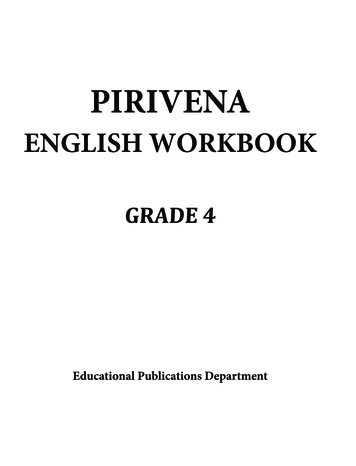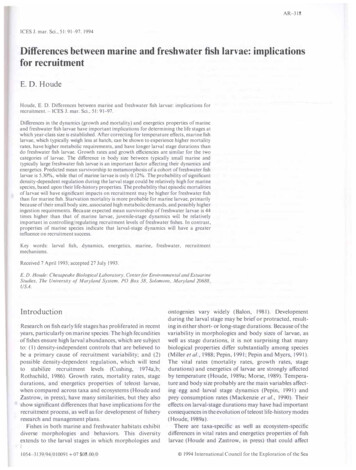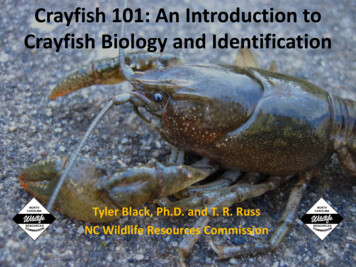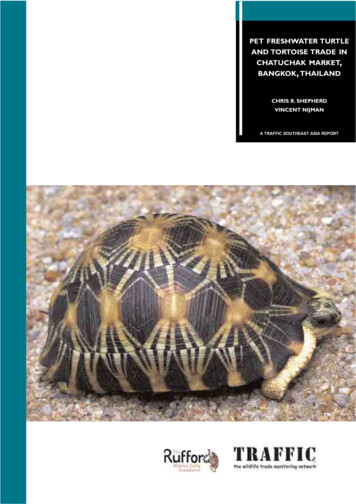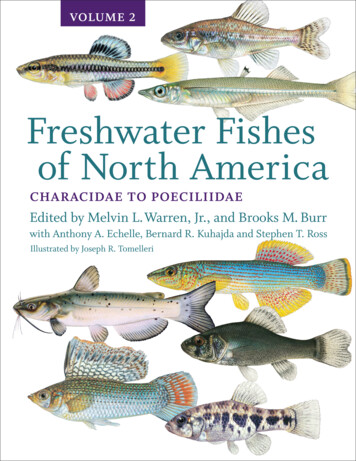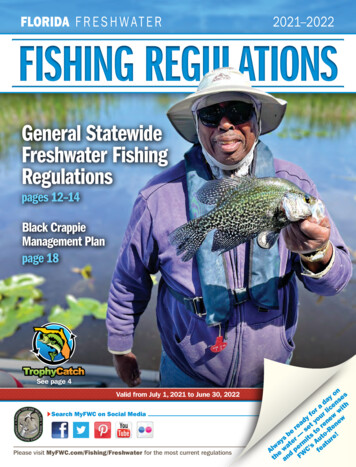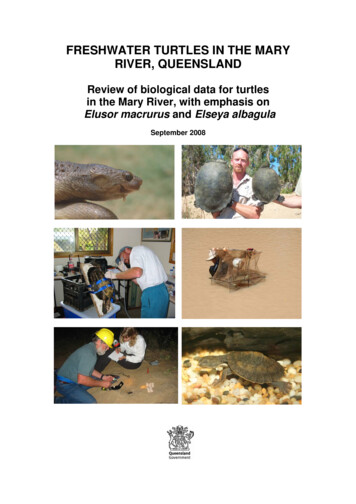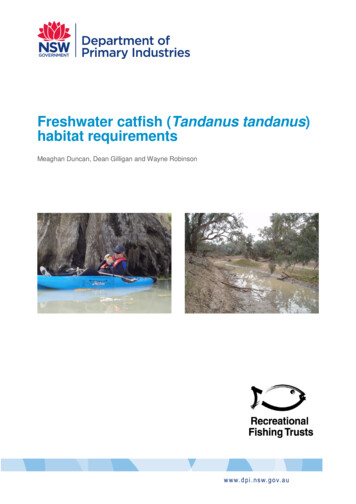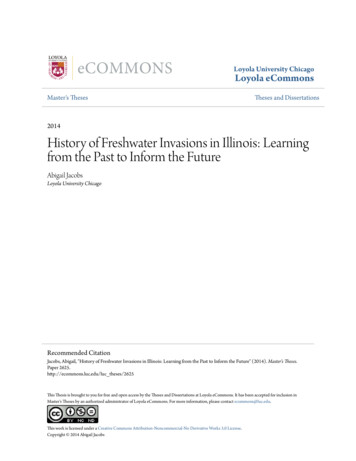
Transcription
Loyola University ChicagoLoyola eCommonsMaster's ThesesTheses and Dissertations2014History of Freshwater Invasions in Illinois: Learningfrom the Past to Inform the FutureAbigail JacobsLoyola University ChicagoRecommended CitationJacobs, Abigail, "History of Freshwater Invasions in Illinois: Learning from the Past to Inform the Future" (2014). Master's Theses.Paper 2625.http://ecommons.luc.edu/luc theses/2625This Thesis is brought to you for free and open access by the Theses and Dissertations at Loyola eCommons. It has been accepted for inclusion inMaster's Theses by an authorized administrator of Loyola eCommons. For more information, please contact ecommons@luc.edu.This work is licensed under a Creative Commons Attribution-Noncommercial-No Derivative Works 3.0 License.Copyright 2014 Abigail Jacobs
LOYOLA UNIVERSITY CHICAGOHISTORY OF FRESHWATER INVASIONS IN ILLINOIS:LEARNING FROM THE PASTTO INFORM THE FUTUREA THESIS SUBMITTED TOTHE FACULTY OF THE GRADUATE SCHOOLIN CANDIDACY FOR THE DEGREE OFMASTER OF SCIENCEPROGRAM IN BIOLOGYBYABIGAIL I. JACOBSCHICAGO, ILDECEMBER 2014
Copyright by Abigail I. Jacobs, 2014All rights reserved
ACKNOWLEDGMENTSI would like to thank my advisor Dr. Reuben Keller and my committeemembers Dr. Martin Berg and Dr. Timothy Hoellein for all of their time spentadvising me and their comments that helped me conduct and improve thisresearch. I would like to thank David Treering for his help with ArcGIS. I’d alsolike to thank Keller lab members Ellen Cole and Kevin Scheiwiller for their help invarious parts of this thesis. I couldn’t complete this research without thewillingness of institutions and data contributors to share their records and tocomplete my ecological impacts survey, so thank you for your knowledge anddata. A grant from the Illinois Department of Natural Resources to Dr. ReubenKeller supported this thesis. An IRB through Loyola University Chicago wascompleted for the ecological impacts survey.iii
TABLE OF CONTENTSACKNOWLEDGMENTSiiiLIST OF TABLESvLIST OF FIGURESviABSTRACTviiCHAPTER I: INTRODUCTION1CHAPTER II: STRADDLING THE DIVIDE: INVASIVE AQUATIC SPECIES INILLINOIS AND MOVEMENT BETWEEN THE GREAT LAKES ANDMISSISSIPPI BASINS12CHAPTER III: SPATIAL TRENDS IN THE ARRIVAL AND SPREAD OFAQUATIC INVADERS IN ILLINOIS36CHAPTER IV: CONCLUSION59APPENDIX A: SUPPLEMENTAL TABLES AND FIGURES61REFERENCE LIST87VITA99iv
LIST OF TABLESTable 1. Number of records and established species in Illinois inlandwaters between 1873 and 2012.23Table 2. The 18 established species with an average ecological impactrating of 2.5.27Table 3. The average number of established species per km2 of surfacewater for counties in each invasion corridor category.51Table 4. Sources and number of established aquatic non-native speciesrecords in inland waters of Illinois.63Table 5. The 60 established aquatic non-native species found withinIllinois inland waters.64Table 6. The 39 aquatic non-native species discovered but notestablished in inland waters of Illinois.71Table 7. Respondents (and affiliations) to ecological impacts ofestablished aquatic non-native species survey.74Table 8. Established aquatic non-native species found in each county.75Table 9. Introduced but not established aquatic non-native speciesfound in each county.81v
LIST OF FIGURESFigure 1. Steps in the invasion sequence.4Figure 2. Major rivers and lakes of Illinois.7Figure 3. The most likely direction from which established speciesarrived in Illinois.15Figure 4. Number of established species and number of records by yearwithin Illinois inland waters between 1873 and 2012.20Figure 5. Cumulative number of introduced (gray line) and established(black line) species in Illinois inland waters between 1873 and2012.22Figure 6. Number of species non-native to North America and initial vectorto North American freshwaters.24Figure 7. Average rank of each individual established species.26Figure 8. Number of records of established aquatic non-native species ineach Illinois county.46Figure 9. Number of established aquatic non-native species by county.47Figure 10. County location of each first established species record.49Figure 11. Number of established aquatic non-native species recordswithin Illinois inland waters between 1873 and 2012.62vi
ABSTRACTGlobalization has increased worldwide species invasions at anaccelerating rate over the last century, with freshwater ecosystems particularlyhighly impacted. In North America, Illinois straddles the Laurentian Great Lakesand Mississippi watersheds. Many aquatic non-native species have breachedthis divide by traveling through rivers and canals in Illinois. Preventing futurespecies movement is an important regional and continental priority. The goal ofthis thesis was to assemble a comprehensive database of occurrences of aquaticnon-native species through the invasion sequence, and assess historical,temporal, and geographic trends of species in Illinois. I assembled acomprehensive database of known occurrences of aquatic non-native species(n 99) in Illinois inland waters. I determined their vector, location, current stage inthe invasion sequence (introduction or establishment), and ecological impacts.The arrival of non-native species has accelerated since 1873, and the rate ofspecies establishment has increased linearly. The Great Lakes Basin was themain source of established species into Illinois. Established species that are notnative to North America (n 43) were delivered to the continent historicallythrough deliberate releases (e.g., fish stocking), and unintentional releases (e.g.,solid ballast of ships). Over the last two and a half decades, unintentional release(e.g., shipping) was dominant. Sixty of the 99 introduced species establishedreproducing populations. Eighteen established species had high or very highvii
ecological impacts. Assessing ecological impacts by surveying invasive speciesexperts that have the education and experience with these species in the field isa novel type of impact assessment and is a quick way to assess impacts ofnumerous species. Spatially, established species were more likely to berecorded, and first recorded, along the invasion corridor in Illinois (counties thatcontain the waterways that comprise the aquatic link between Lake Michigan andMississippi River). Established species are spreading into and through theinvasion corridor faster than they can be transported via recreational boatingactivities. Ten established species were recorded in more than 50% of Illinoiscounties while six established species were only found in one county. Irecommend a multi-vector management and policy approach, increasing earlydetection efforts along the invasion corridor, broad sampling of counties with lownumber of records, and increasing efforts to control and slow the spread ofestablished species in Illinois that cause the highest ecological impacts. Becauserivers and canals in Illinois act as conduits of aquatic invasive species betweenthe Great Lakes and Mississippi River Basins, it should be a management focusfor North America. Only with cooperation at regional, national, and internationalscales, can we properly address the increasing introduction, establishment,spread, and potential impacts of non-native species.viii
CHAPTER IINTRODUCTIONNon-native SpeciesThe introduction and spread of invasive species has increased worldwide,especially in freshwater ecosystems (Mills et al. 1993; Ricciardi 2006; Keller, ZuErmgassen, and Aldridge 2009). Non-native species have been transportedbeyond their native range and introduced to a new region usually by humanactivity either deliberately or unintentionally (Kolar and Lodge 2001). In theUnited States, species are generally considered non-native if they wereintroduced by humans after European colonization and do not have anyevolutionary history in the new region (Ricciardi 2006).Established species are non-native species with a reproducing populationoutside their native range (Kolar and Lodge 2001; Keller, Zu Ermgassen, andAldridge 2009). Once non-native species are established, eradication is nearlyimpossible (Carpenter, Stanley, and Vander Zanden 2011; Vander Zanden et al.2010). Therefore, it is essential to understand how non-native species establishand spread in new regions, and then to apply appropriate managementtechniques so that their impact can be minimized if they become invasive (Lodgeet al. 2006).Three definitions of invasive species have been proposed, eachcorresponding to different aspects of the impacts that these species can1
2have. In the management definition, invasive species are non-native species thathave established reproducing populations that cause harm or have the potentialto cause harm to other native biota, humans, or the economy (US President1999). The second definition is focused on ecology, and holds that invasivespecies are simply those non-native species that have established a reproducingpopulation beyond their native range (Ricciardi 2006). The third definition holdsthat an invasive species is a non-native species that spreads from its introductionpoint and becomes abundant (Kolar and Lodge 2001). For the purposes of thisthesis, invasive species are those non-native species that are established with areproducing population outside their native range and have spread from theirintroduction point and caused harm, or have the potential to cause harm to othernative biota, humans, or the economy.Not all non-native species become invasive as defined for this thesis. Todo this they must move through all steps of the invasion sequence To becomeinvasive, a non-native species must be transported, released, and then becomeestablished. Finally, a species must spread and cause harm.(Figure 1; Kolar andLodge 2001). In the first of these steps, the species must be moved through atransport vector. A species that enters the transport pathway does notnecessarily have a chance to move outside its native range and become nonnative. This is because different vectors have different levels of organism survivalen route. For example, unintentional vectors like ballast water may have lowsurvivorship, while intentional vectors like the aquarium trade are likely to havehigh survivorship. In the second step, the species has survived transport to a
3new region. Once in this new region the species could fail to be released, ormove onto the third step where it is released into the new region. Once releasedin the new region, these species are introduced non-native species. Introducedspecies may not persist due to environmental conditions and interactions withother organisms in the new ecosystem, including native and non-native species.The fourth step is passed if the introduced non-native species establishesreproducing populations in the non-native region, at which point it is referred toas established. The fifth and final step is reached if the non-native speciesspreads widely and causes impacts (i.e., becomes an invasive species; Kolarand Lodge 2001). In general, a small fraction of non-native species becomeinvasive (Williamson and Fitter 1996), although any species that enters theinvasion sequence could potentially move completely through the entiresequence.Potential non-native aquatic species are transported to new regionsthrough many vectors of transportation and commerce (step 2 in Figure 1).Unintentional vectors of transportation, which are byproducts of human activity,include shipping activities through ballast water and hull fouling (Holeck et al.2004; Grigorovich et al. 2003), recreational boating and fishing gear, and throughthe aquarium trade (Keller and Lodge 2009; Mills et al. 1993). Deliberate vectors,which are when humans knowingly release non-native species into theenvironment, include transport of sport fish to stock lakes outside their nativerange, aquaculture, through live food and bait trades, and through thewatergarden trade (Ricciardi, 2006). With globalization, the number of transport
4Figure 1. Steps in the invasion sequence. Green arrows indicate successfulmovement of a species through the pathway while red arrows indicate failure of aspecies to move onto the next step. Adapted from Kolar and Lodge, 2001.vectors, release events, and the number of introduced non-native species hasincreased in the Great Lakes Basin (Ricciardi 2006).Invasive species can negatively affect ecosystems and human activities.They can decrease native biodiversity by outcompeting native species forresources, through predation, and/or through altering patterns of disturbance(Mills et al. 1993; Sax et al. 2007). For example, predatory lionfishes (Pteroisvolitans and P. miles), most likely were transported and released through theaquarium trade to the western Atlantic Ocean (Whitfield et al. 2002). These
5species have established and quickly spread throughout the western NorthAtlantic Ocean, Caribbean, and Gulf of Mexico (Schofield 2010). Large impactshave been documented, including decreased recruitment of native fishes due topredation by lionfishes(Albins and Hixon 2008), and a substantial decline in thebiomass of the lionfishes’ prey fishes (Green et al. 2012).Invasive species cause about 120 billion each year in the United Statesin environmental damages (Pimentel, Zuniga, and Morrison 2005). One exampleof a particularly damaging species is the zebra mussel (Dreissena polymorpha).The zebra mussel was transported from Eurasia via ballast water in ships andwas first introduced to Lake St. Clair (Mills et al. 1993). Zebra mussels haveestablished and spread from the Great Lakes Basin across North America,causing tens of millions of dollars in damage to industry in the US, while alsodecreasing native unionid mussels richness and abundance (Drake andBossenbroek 2004; Bossenbroek et al. 2007). Zebra mussels clog water intakeand outtake pipes of factories and water treatment plants (Mills et al.1993).Treatment plants and factories must remove pipes and experiment withcontrol efforts which range in their effectiveness and cost (Leung et al. 2002).Invasive species also affect the aesthetics of water bodies. For example,Eurasian watermilfoil (Myriophyllum spicatum) creates dense canopies in waterbodies that limit opportunities for fishing and swimming (Jerde et al. 2010).Freshwater ecosystems and invasions in Illinois, including the Great LakesThe state of Illinois has a high diversity of freshwater ecosystems (Figure2). The northeast of the state borders Lake Michigan, which is connected to the
6rest of the Laurentian Great Lakes and the Atlantic Ocean via the St. LawrenceRiver. There are several small rivers that flow into Lake Michigan from Illinois, butmost of the state is in the Mississippi River Basin. The Chicago Area WaterwaysSystem (CAWS) connects Lake Michigan to the Des Plaines River, which flowsinto the Illinois River, and into the Mississippi River (which comprises the westernborder of the state). The Wabash and Ohio Rivers comprise the southeasternborder and also flow into the Mississippi River. Lakes in Illinois are man-made,such as Lake Shelbyville and Carlyle reservoirs along the Kaskaskia River, andnatural (e.g Horseshoe Lake in St. Louis near the Mississippi River). Illinois alsocontains wetlands, with almost half of Illinois’s wetlands located in the southernthird of the state (Suloway and Hubbell 1994).
7Figure 2. Major rivers and lakes of Illinois (Mapsof.net, 2012).Most freshwater ecosystems in Illinois have been extensively altered byhumans, including the creation of reservoirs and the loss of wetlands. Many lakesact as reservoirs for to regulate drought and flood conditions. Historically, 23% ofIllinois surface area was composed of wetlands, however, currently only 3.5% ofIllinois is covered by wetlands (McCauley and Jenkins 2005; Suloway andHubbell 1994).
8Perhaps the greatest alteration to aquatic ecosystems in the region byhumans was the creation of the Chicago Sanitary and Ship Canal (CSSC) whichwas completed in 1900 and connects the Mississippi and Lake Michigan watersystems through the Des Plaines and Illinois Rivers (Jerde et al. 2010). Thispermitted the flow of the Chicago and Calumet Rivers to be connected andreversed, allowing for transport of waste and storm water away from Chicago andfacilitating shipping. This canal facilitates the movement of invasive speciesbecause it is a permanent aquatic connection between the Mississippi River andGreat Lakes Basins (Horner, Sparks, and Charlebois 1999). One imminentinvasion that may occur through the CSSC is the movement of silver carp(Hypophthalmichthys molitrix) and bighead carp (H. nobilis), collectively knownas Asian carp, through the Mississippi and Illinois Rivers into Lake Michigan.Some evidence suggests that these species are either already in Lake Michiganor will arrive soon, (Jerde et al. 2010; Jerde et al. 2011).The Great Lakes Basin is a highly invaded system with 182 establishednon-native species (Ricciardi 2006). Non-native species came with increasinghuman populations in the Great Lakes Basin (Mills et al. 1993). For example,power plants have created favorable warmer localized habitats in which warmwater species can survive cold winter temperatures in the Great Lakes (Mills etal. 1993). Human vectors now connect the Great Lakes to freshwaterecosystems throughout the world via planes, automobiles, and ships, whichfrequently travel from all major global coastal regions to the Great Lakes (Kelleret al. 2011). The opening of the St. Lawrence Seaway in 1959 (a canal and lock
9system that connects Lake Ontario to Montreal, Canada), has enhancedmovement of goods and non-native species throughout the Great Lakes via ships(Ricciardi 2006) This increasing globalization and movement of goods providesan opportunity for growth in biological invasions (Mack et al. 2000; Hulme 2009).The areas of Illinois in the Mississippi River Basin are also highly invaded.Round goby (Neogobius melanstomus) has expanded its range through theIllinois Waterway and into the Illinois River (Irons, McClelland, and Pegg 2006).Other widespread, non-native fish species include white perch (MoroneAmericana), bighead carp (Hypophthalmichthys nobilis), silver carp (H. molitrix),common carp (Cyprinus carpio), and goldfish (Carassius auratus; Irons et al.2006; Sparks 2010). In addition to fish, Illinois has non-native mollusks (e.g.,zebra mussels [Dreissena polymorpha], and Asian clam [Corbicula fluminea]),crustaceans (e.g., rusty crayfish [Orconectes rusticus]), and many non-nativeaquatic plants (e.g., purple loosestrife [Lythrum salicaria], curly pondweed[Potamogeton crispus], and Eurasian watermilfoil [Myriophyllum spicatum]).Thesis ProjectThe initial goal of this thesis project was to create a comprehensivedatabase of non-native aquatic species occurrences in Illinois, because Illinois’srecords were in scattered datasets that existed in various places and files acrossIllinois. These datasets typically are regional in scope or taxonomy. Policymakers and managers often rely on these scattered and incomplete datasets toestablish targets for reducing arrival and spread of invasive species (Keller, ZuErmgassen, and Aldridge 2009; Fuentes et al. 2013). If the historical data are not
10complete and organized, it hinders the ability of managers and policy-makers toeffectively manage limited budgets. Therefore, a comprehensive database isneeded to inform policy-makers and managers in the state, and improveeffectiveness of strategies to control invasive species in Illinois.I assembled a database of aquatic non-native species and present myanalysis of the data here. In chapter II, I describe species trends through timeand at each step in the invasion sequence. In chapter III I describe specieshistorically, temporally, and spatially by county. Both of these chapter results arediscussed in in the context of management and policy on aquatic non-nativespecies.The goal of Chapter II was to assess aquatic non-native species in eachstep of the invasion sequence (introduced, established, and invasive) in Illinois.This is needed because different management actions are required dependingon which step each species is found. I determined the establishment status ofeach introduced aquatic non-native species. Because the ecological impacts offew established species have been studied in Illinois, and established speciesare observed regularly in the field by educated ecologists, I conducted a surveyof Illinois invasive species experts to determine the average level of ecologicalimpacts caused by each established species. For each stage in the invasionsequence, I examined vectors or time periods that have been particularlyimportant. I also determined which species and the number of species thatspread into Illinois via the Great Lakes and the Mississippi River.
11The goal of chapter III was to assess historical, temporal, and geographictrends in the arrival and spread of aquatic invaders in Illinois. I determined whichareas were most important as points of introduction for new species, and whichcontained the greatest numbers of established aquatic non-native species. Next,I determined the most likely vectors for each species to Illinois to infer whichmodes of human transport have been most important. Finally, I gatheredstatewide data at the county scale to test the importance of some human andenvironmental factors that are strongly associated with species introduction andspread . My ultimate goal was to provide information useful to prevent andreduce the overall impacts from non-native species.
CHAPTER IISTRADDLING THE DIVIDE: INVASIVE AQUATIC SPECIES IN ILLINOIS ANDMOVEMENT BETWEEN THE GREAT LAKES AND MISSISSIPPI BASINSIntroductionRates of introduction and spread of non-native species continue toincrease worldwide, with freshwater ecosystems highly impacted (e.g., Ricciardi2006; Keller et al. 2009). Human actions have connected aquatic ecosystemsdirectly (e.g. canals; Mills et al. 1993) and indirectly (e.g. international shippingand aquarium trades; Ricciardi 2006; Keller et al. 2011), allowing forunprecedented movement and introduction of non-native species across naturalbarriers. Many of these species become established and a portion have largeecological and economic impacts.To become invasive, non-native species must be transported, introducedbeyond captivity, establish reproducing population(s), spread, and cause harm(Kolar and Lodge 2001). Although many studies have determined the suite ofnon-native species that have been introduced to a region, and the subset ofthose that have become established, few studies have quantitatively assessedwhich established species have become invasive. This is partly due to thedifficulty in defining invasive. For example, some authors believe this designationshould be reserved strictly to describe ecological impacts, while12
13others believe it should be used for species that negatively impact the economyor human health (Colautti and MacIsaac 2004). In reality, negative impacts fromnon-native species occur as a gradation from low to high, and the single terminvasive does not capture these differences. Despite this, it is important formanagers and policy-makers to know the number and type of species that are ormay become invasive in their region. Under any definition of invasive thesespecies are those which control is most likely to be required. Information aboutrealized or likely impacts of invasive species can be used to prioritize preventionand control strategies and to assess which vectors have imported the greatestnumber of harmful species.Understanding the introduction, establishment, and impacts of aquaticnon-native species in the US state of Illinois is particularly important because itcontains part of the boundary between the Laurentian Great Lakes andMississippi River Basins and the canals which connect the two basins (Figure 3).These basins are among the most economically important in North America, andinvasive species threaten many of the ecosystem services that they provide. Thelargest connection between these basins is Illinois’ Chicago Sanitary and ShipCanal (CSSC), which opened in 1900 to facilitate navigation between the basinsand disposal of sewage. This is the only connection between the two basins inwhich a continuous aquatic habitat is maintained throughout the year even at lowflow conditions (US Army Corps of Engineers 2013). This connection has allowedspecies to move between basins (Horner, Sparks, and Charlebois 1999),
14including the zebra mussel (Dreissena polymorpha), which spread from the GreatLakes to the Mississippi, and subsequently as far as California (US GeologicalSurvey, 2012-2014). Currently, the role of the CSSC for species range expansionhas been highlighted by the potential for bighead (Hypophthalmichthys nobilis)and silver carp (Hypophthalmichthys molitrix; these species are often collectivelyreferred to as Asian carp) to enter the Great Lakes at Lake Michigan.Species can be introduced to Illinois either through direct introduction(e.g., releases by aquarists and escape from watergardens) or through spreadfrom neighboring states and waterbodies. Spread from outside Illinois may occuras species naturally move through connected waterbodies, such as theMississippi River or Lake Michigan, or when species are transported overlandfrom other states (e.g. on recreational boats). The CSSC connection of the GreatLakes and Mississippi River Basins within Illinois means that invasions whichoccur in and spread through the state can have important consequences formuch of North America. Thus, a better understanding of the range of species thatare established and invasive, and the vectors that have transported them, couldinform management and policy with continent-wide implications.Because of the need for baseline information by scientists, managers, andpolicy-makers, I assessed aquatic non-native species in each step of theinvasion sequence (introduced, established, and invasive) in Illinois. I assembleda database of all aquatic non-native species recorded in the state, includingestablishment. I conducted an innovative survey of Illinois invasive speciesexperts to measure the ecological impacts caused by each established species
15because these experts have the education and experience with these species inthe field. For each stage in the invasion sequence, I examined the vectors andtime periods responsible for Illinois species invasion.Figure 3. The most likely direction from which established species arrived inIllinois (IL). Twenty-eight species were established in the Great Lakes Basin, butnot the Mississippi River Basin, prior to their discovery in Illinois. Six specieswere established in the Mississippi Basin prior to discovery in Illinois, and 20species have an unknown source.
16MethodsDatabase DevelopmentI defined Illinois to include all inland waters of the state, including thoseparts of the rivers (Mississippi, Ohio, and Wabash) that form its border. Illinoisalso includes a portion of Lake Michigan. This was not included in my databasebecause its boundaries are not ecological and is more appropriately consideredpart of the larger Great Lakes ecosystem.From personal and institutional databases, published literature, and directcontact with experts, I compiled a list of records for aquatic species documentedin Illinois that are not native to any part of the state (see Table 4 in appendix).Species were classified as introduced if they were recorded at least once beyonddirect human cultivation, and established if at least one population wasreproducing. I searched all available sources.For aquatic plants, I used the USDA PLANTS definition of obligatewetland, which is that the species occurs (under natural conditions) in wetlandswith a 99% probability (USDA NRCS 2012). Parts of Illinois fall into four USDAwetland regions, and any plant species defined as obligate wetland within one ormore of those regions was included (Lichvar 2012). The only exception to thiswas common reed (Phragmites australis), which is classified as a facultativewetland species but was included because of its large impacts on wetlands(Meyerson et al. 2000; Chambers, Meyerson, and Saltonstall 1999).For some plant species I found conflicting reports of whether they arenative to Illinois. In these cases I assessed the data used by different sources
17(e.g., USDA PLANTS database [USDA NRCS 2013], BONAP [Kartesz 2013],Swink and Wilhelm [1994]) to make my decision, and then confirmed thatdecision with local experts and recent literature (e.g. Stuckey and Salamon 1987;Saltonstall 2002; Stevens and Hoag 2006; Saltonstall 2013; Ciotir et al. 2013).For each species, I recorded the location and date of sampling, status ofthe population (i.e., established vs. not established), and the researcher identity.When location data were not given as latitude and longitude coordinates I useddescriptions of sampling sites to estimate coordinates. When this was notpossible, the record’s location was designated at the county level. Duplicaterecords were removed when species, date, location, and researcher identity wereidentical.Analysis of Introduction and Establishment RecordsAverage annual rate of new species discovery was calculated for each 10year period between 1873 (the year of first discovery of a non-native species)and 2012. Linear regression on this time series was used to determine if rate ofdiscovery has changed over time.For species not native to any part of North America, I determined the mostlikely vector that delivered them to the continent. Following Ricciardi (2006),these vectors were shipping (including ballast water, solid ballast, and hullfouling), deliberate release through production or stocking efforts, unintentionalrelease (including ornamental and aquaculture escape, and bait bucket release),aquarium
Figure 7. Average rank of each individual established species. 26 Figure 8. Number of records of established aquatic non-native species in each Illinois county. 46 Figure 9. Number of established aquatic non-native species by county. 47 Figure 10. County location of each first established species record. 49 Figure 11.
